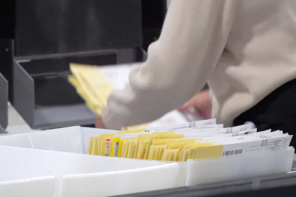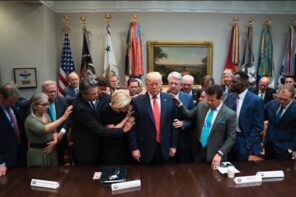This Religious Freedom Day, January 16th, we want to highlight the idea that religious freedom is inescapably linked with reproductive freedom. We cannot fully have one without the other.
Religious Freedom Day was designated by Congress to commemorate the enactment of the Virginia Statute for Religious Freedom in 1786. The first such legislation in the history of the world, it has informed the highest aspirations of American democracy ever since.
While some of our many religious traditions won’t acknowledge it, when individuals make reproductive decisions—contraception, fertility treatment, termination of a pregnancy, adoption, etc.—they’re exercising their right to conscience. This may not have been anticipated by the gentlemen of 18th century Virginia, but it is consistent with their view that people have the right to decide matters of conscience without the interference of government or powerful religious institutions—what we still call religious freedom.
But this and other foundational values of democracy have been under siege, as political, legislative and judicial deference is increasingly granted to a narrow band of religious authoritarians we sometimes call Christian Nationalists or Dominionists. (Contrary to stereotype, it’s not just white evangelicals. There are, for example, plenty of allied Catholics who have instigated the otherization and assault on people who don’t share their views.)
We saw some of them participate in the recent insurrectionist events at the U.S. and State capitol buildings. These events reveal how exclusivist notions of Christianity have been allowed to run roughshod over people of other religious traditions, including many fellow Christians. Throughout history, the rise of such religious supremacism has led to brutality. But one of the strengths of a democratic, pluralist society is that we have the capacity and potential resilience to overcome such singular drives for power. It’s that very resilience we are calling for this Religious Freedom Day, as we recognize the strengths of diversity and equality under the law.
A civil body politic
We’re reminded that the history of the idea of religious freedom in North America harkens further back, to the Pilgrims—Congregationalists who were fleeing oppression by the Anglican Church, the official church of the British Empire. In 1620, the signers of the Mayflower Compact declared “we solemnly and mutually in the presence of God, and one another, covenant and combine our selves together into a civil body politic, for our better ordering and preservation.”
But soon, the supposed better order established by the colonists of Massachusetts Bay tended towards exclusivism, dominance, and supremacy—as other religious groups arrived; in bloody relation to indigenous peoples; and as some people deviated from the orthodoxy of the day.
In the face of all this, suffice to say, it took time to identify and to agree on shared democratically framed principles to guide a “civil body politic” in all of the colonies. But this, and the paradox of seeking freedom for some while denying it to others—and worse—is part of the story of religious freedom in the U.S. that evolves and continues to this day. Paradoxes notwithstanding, it remains important to follow the through line of one of the most powerfully liberatory ideas in history lest we lose sight of who we’ve been, and who we need to become and the opportunities afforded us all by knowing in our bones the authentic meaning of religious freedom in our time. And this means, by the way, being able to say without hesitation or qualification what religious freedom is, and not only what it is not.
A century and a half later, Thomas Jefferson, fresh from having drafted the Declaration of Independence in Philadelphia, went home and drafted the Virginia Statute for Religious Freedom in 1777. The bill helped rally Virginia’s Baptists and Presbyterians to the cause of the Revolution, which envisioned a future free from persecution by the Anglican Church. It took nearly a decade for the liberatory promise of Jefferson’s bill to become law under the legislative leadership of James Madison. From there, the vision of religious freedom slowly advanced to become a central feature of the framework of American constitutional democracy.
The Virginia Statute declared, “…all men shall be free to profess, and by argument to maintain, their opinions in matters of religion, and that the same shall in no wise diminish, enlarge, or affect their civil capacities.” Worried about backsliding and revisionism regarding this legacy, Jefferson later wrote that the vision of religious freedom intended by the Statute encompasses “the Jew and the Gentile, the Christian and Mahometan, the Hindoo, and infidel of every denomination.”
Following his historic legislative victory with the Virginia Statute, Madison traveled to Philadelphia in 1787 where he was a principal author of the Constitution, and, two years later, of the First Amendment. Unsurprisingly, the Virginia Statute has long been understood by scholars and by the U.S. Supreme Court to be an authoritative source for the meaning of religious freedom.
While Madison, Jefferson and the seminal documents they helped frame in their time had a broad understanding of the importance of freedom of religion and conscience for the well-being of the “civil body politic,” they didn’t recognize how critical gender justice and reproductive freedom are, not only for the health of the democracy but religious freedom itself. That work is ours in this era.
The two of us who co-author this essay have come together—a white man whose body was always considered as part of the “civil body politic” from the early colonies, and a Black woman whose body never was considered a part—to invite all Americans to a closer examination of religious freedom and its critical connection with reproductive freedom.
The Virginia Statute places the locus of the right of religious freedom with individual citizens and not with powerful institutions of religion and government. The most important words in the Virginia Statute are about religious equality—essentially that one’s religious identity should be neither an advantage nor a disadvantage under the law.
Rolling back a natural right
Jefferson also cast a weather eye to the future—writing in the Statute itself that, “the rights hereby asserted, are of the natural rights of mankind,” and any legislation that repeals the statute “will be an infringement of a natural right.”
Today we must extend this foundational principle for ordering society first articulated in the Virginia Statute, that one’s religious identity must also be neither an advantage nor a disadvantage to individuals as they make private life decisions.
The modern descendants of the early Congregationalists is the United Church of Christ (UCC), a national denomination that has long recognized that different religions approach matters of reproductive decision-making differently, and that for one group to impose its views on others is a violation of religious freedom under the First Amendment.
We think it’s time for us all to seek religious freedom for reproductive freedom, and to recognize that persistent efforts to interfere in reproductive decisions is “an infringement of a natural right” in the sense the Virginia Statute warned.
Of course, women didn’t share in this natural right at the time—but the right to believe differently than the rich and the powerful as codified in the Statute and the First Amendment, is what allowed for every advance in human and civil rights since—including the extension of this right to women.
We recognize that the Christian Right argues that for Christians to take a pro-choice stance and advocate for reproductive freedom is accommodating to “modern secular beliefs and it flies in the face of the Bible and the historical position of the church.” But contrary to this Manichaean suggestion, reproductive freedom isn’t necessarily an entirely secular matter.
Indeed, in addition to the UCC, a number of Christian and Jewish traditions with roots in the colonial era, and many others since have come to embrace the values of reproductive choice and justice within their belief systems and therefore the principle of religious freedom that protects them all under the Constitution. They understand that how and when and under what circumstances women bring children into the world is a matter for their own conscience, not for other individuals or other religious institutions or the government.
These and members of all and no religious traditions have the equal “right of individual conscience,” as Madison put it. Or as Jefferson put it, the “freedom of the mind” to make their own decisions. This is why the ideas of religious freedom that made democracy possible are the root of what makes reproductive freedom possible today.
The rollback of religious freedom that the sponsors of the Virginia Statute warned us about is well underway. We can see it in the recent and likely future decisions of the Supreme Court, the damage done by the Trump administration, and in the theocratic agenda of the Christian Right, a movement that continues to grow in political power. But their day is not forever.
We know that it will take time and struggle to regain what has been lost to the theocratic operatives of the Christian Right and their enablers in politics and government. But we also know that the prochoice religious community is vast and growing, and that, along with non-religious Americans, they constitute a majority.
We may be on the verge of action on how the promise of religious freedom can deliver reproductive freedom in our time. And we can envision a time when people won’t be able to remember that there was ever a time when reproductive freedom was in doubt. What they may call history, could be our future.





